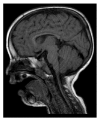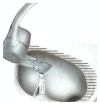Original Solution for Middle Ear Implant and Anesthetic/Surgical Management in a Child with Severe Craniofacial Dysmorphism
- PMID: 26491591
- PMCID: PMC4602318
- DOI: 10.1155/2015/205972
Original Solution for Middle Ear Implant and Anesthetic/Surgical Management in a Child with Severe Craniofacial Dysmorphism
Abstract
We describe the novel solution adopted in positioning middle ear implant in a child with bilateral congenital aural atresia and craniofacial dysmorphism that have posed a significant challenge for the safe and correct management of deafness. A five-year-old child, affected by a rare congenital disease (Van Maldergem Syndrome), suffered from conductive hearing loss. Conventional skin-drive bone-conduction device, attached with a steel spring headband, has been applied but auditory restoration was not optimal. The decision made was to position Vibrant Soundbridge, a middle ear implant, with an original surgical application due to hypoplasia of the tympanic cavity. Intubation procedure was complicated due to child craniofacial deformities. Postoperative hearing rehabilitation involved a multidisciplinary team, showing improved social skills and language development.
Figures
Comment in
-
Comment on "Original Solution for Middle Ear Implant and Anesthetic/Surgical Management in a Child with Severe Craniofacial Dysmorphism".Case Rep Otolaryngol. 2016;2016:2859051. doi: 10.1155/2016/2859051. Epub 2016 Jul 25. Case Rep Otolaryngol. 2016. PMID: 27523250 Free PMC article. No abstract available.
References
-
- Roberson J. B., Jr., Goldsztein H., Balaker A., Schendel S. A., Reinisch J. F. HEAR MAPS a classification for congenital microtia/atresia based on the evaluation of 742 patients. International Journal of Pediatric Otorhinolaryngology. 2013;77(9):1551–1554. doi: 10.1016/j.ijporl.2013.07.002. - DOI - PubMed
-
- Snik A. F., Mylanus E. A., Proops D. W., et al. Consensus statements on the BAHA system: where do we stand at present? The Annals of Otology, Rhinology & Laryngology. Supplement. 2005;195:2–12. - PubMed
LinkOut - more resources
Full Text Sources
Other Literature Sources




